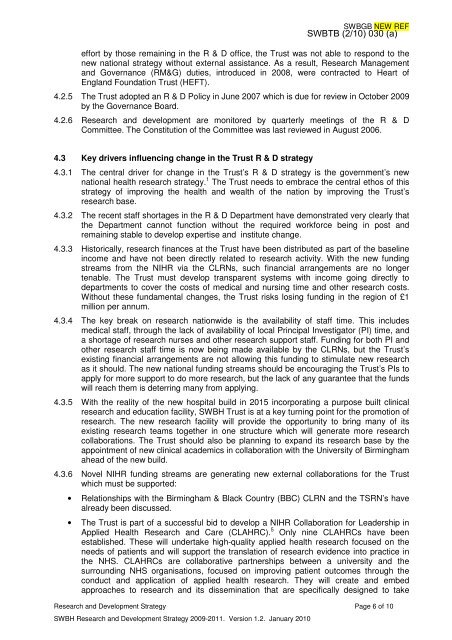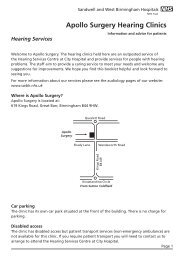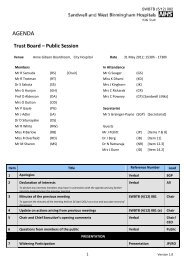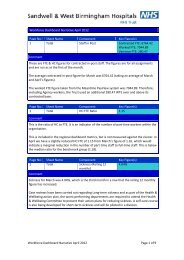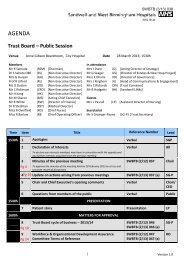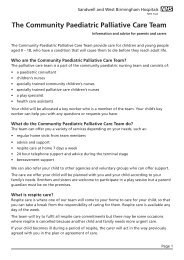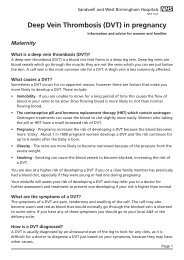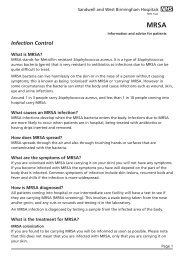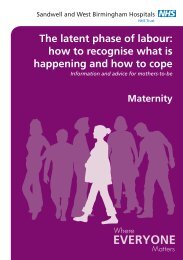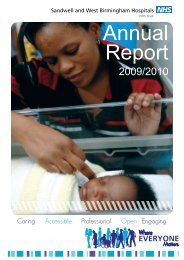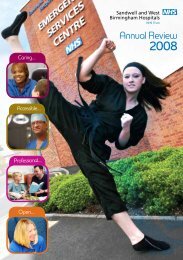Trust Board Febuary 2010 - Sandwell & West Birmingham Hospitals
Trust Board Febuary 2010 - Sandwell & West Birmingham Hospitals
Trust Board Febuary 2010 - Sandwell & West Birmingham Hospitals
You also want an ePaper? Increase the reach of your titles
YUMPU automatically turns print PDFs into web optimized ePapers that Google loves.
SWBGB NEW REF<br />
SWBTB (2/10) 030 (a)<br />
effort by those remaining in the R & D office, the <strong>Trust</strong> was not able to respond to the<br />
new national strategy without external assistance. As a result, Research Management<br />
and Governance (RM&G) duties, introduced in 2008, were contracted to Heart of<br />
England Foundation <strong>Trust</strong> (HEFT).<br />
4.2.5 The <strong>Trust</strong> adopted an R & D Policy in June 2007 which is due for review in October 2009<br />
by the Governance <strong>Board</strong>.<br />
4.2.6 Research and development are monitored by quarterly meetings of the R & D<br />
Committee. The Constitution of the Committee was last reviewed in August 2006.<br />
4.3 Key drivers influencing change in the <strong>Trust</strong> R & D strategy<br />
4.3.1 The central driver for change in the <strong>Trust</strong>’s R & D strategy is the government’s new<br />
national health research strategy. 1 The <strong>Trust</strong> needs to embrace the central ethos of this<br />
strategy of improving the health and wealth of the nation by improving the <strong>Trust</strong>’s<br />
research base.<br />
4.3.2 The recent staff shortages in the R & D Department have demonstrated very clearly that<br />
the Department cannot function without the required workforce being in post and<br />
remaining stable to develop expertise and institute change.<br />
4.3.3 Historically, research finances at the <strong>Trust</strong> have been distributed as part of the baseline<br />
income and have not been directly related to research activity. With the new funding<br />
streams from the NIHR via the CLRNs, such financial arrangements are no longer<br />
tenable. The <strong>Trust</strong> must develop transparent systems with income going directly to<br />
departments to cover the costs of medical and nursing time and other research costs.<br />
Without these fundamental changes, the <strong>Trust</strong> risks losing funding in the region of £1<br />
million per annum.<br />
4.3.4 The key break on research nationwide is the availability of staff time. This includes<br />
medical staff, through the lack of availability of local Principal Investigator (PI) time, and<br />
a shortage of research nurses and other research support staff. Funding for both PI and<br />
other research staff time is now being made available by the CLRNs, but the <strong>Trust</strong>’s<br />
existing financial arrangements are not allowing this funding to stimulate new research<br />
as it should. The new national funding streams should be encouraging the <strong>Trust</strong>’s PIs to<br />
apply for more support to do more research, but the lack of any guarantee that the funds<br />
will reach them is deterring many from applying.<br />
4.3.5 With the reality of the new hospital build in 2015 incorporating a purpose built clinical<br />
research and education facility, SWBH <strong>Trust</strong> is at a key turning point for the promotion of<br />
research. The new research facility will provide the opportunity to bring many of its<br />
existing research teams together in one structure which will generate more research<br />
collaborations. The <strong>Trust</strong> should also be planning to expand its research base by the<br />
appointment of new clinical academics in collaboration with the University of <strong>Birmingham</strong><br />
ahead of the new build.<br />
4.3.6 Novel NIHR funding streams are generating new external collaborations for the <strong>Trust</strong><br />
which must be supported:<br />
• Relationships with the <strong>Birmingham</strong> & Black Country (BBC) CLRN and the TSRN’s have<br />
already been discussed.<br />
• The <strong>Trust</strong> is part of a successful bid to develop a NIHR Collaboration for Leadership in<br />
Applied Health Research and Care (CLAHRC). 5 Only nine CLAHRCs have been<br />
established. These will undertake high-quality applied health research focused on the<br />
needs of patients and will support the translation of research evidence into practice in<br />
the NHS. CLAHRCs are collaborative partnerships between a university and the<br />
surrounding NHS organisations, focused on improving patient outcomes through the<br />
conduct and application of applied health research. They will create and embed<br />
approaches to research and its dissemination that are specifically designed to take<br />
Research and Development Strategy Page 6 of 10<br />
SWBH Research and Development Strategy 2009-2011. Version 1.2. January <strong>2010</strong>


